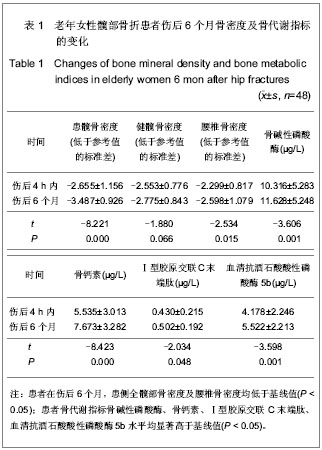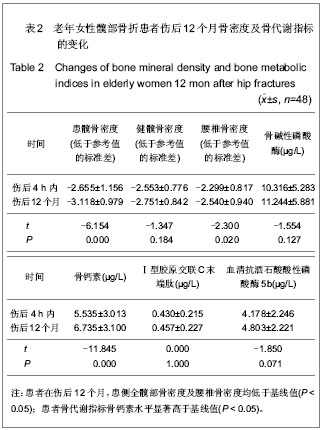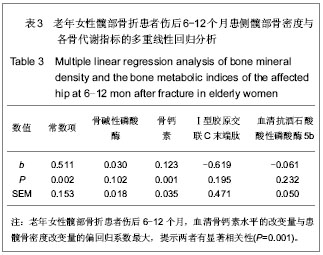| [1] 孟迅吾. 原发性骨质疏松的风险因素和风险评估[J].诊断学理论与实践,2012,11(1):1-4.[2] 蔡树鹏,周先来,黄坚霖,等.老年人髋部骨折与骨质疏松发病率的相关性研究[J].中国当代医药,2013,22(20):30-31.[3] Smulders E, Weerdesteyn V, Groen BE, et al. Efficacy of a short multidisciplinary falls prevention program for elderly persons with osteoporosis and a fall history a randomized controlled trial. Arch Phys Med Rehabil. 2010;91(11): 1705-1711. [4] Yesil Y,Ulger Z ,Halil M, et al. Coexistence of osteoporosis OP and coronary artery disease CAD in the elderly it is not just a by chance event. Arch Gerontol Geriatr. 2012;54(3):473-476. [5] Kouda K, Iki M, Fujita Y, et al. Alcohol intake and bone status in elderly Japanese men baseline data from the Fujiwarakyo osteoporosis sk in men FORMEN study. Bone. 2011;49(2): 275-280. [6] 陆铁,仲维佳,周君琳,等.全身振动对预防老年女性骨质疏松性骨折的作用[J].中华临床医师杂志:电子版,2012,6(5):1113-1116. [7] 杨涛涛,吕晓红,任凤华,等.老年骨质疏松性骨折患者的危险因素与干预措施[J].现代预防医学,2012,39(11):2756-2760. [8] Nguyen ND, Pongchaikayul C, Center JR, et al. Identification of high-risk individuals for hip fracture: a 14-year prospective study. J Bone Miner Res. 2005;20:1921-1928.[9] Xia WB, He SL, Xu L, et al. Rapidly increasing rates of hip fracture in Beijing, China. J Bone Miner Res. 2012;27: 125-129. [10] Starr AJ, Nakatani T, Reinert CM, et al. Superior pubic ramus fractures fixed with percutaneous screws : what predicts fixation failure? J Orthop Trauma. 2008;22(2):81-87. [11] Cooper C, Campion G, Melton LR. Hip fractures in the elderly: a world- wide projection. Osteoporos Int. 1992; 6: 285-289.[12] 李涛,刘智,孙天胜,等.老年髋部骨折后对侧髋部的再骨折[J]. 中国组织工程研究与临床康复,2012,16(4):752-756. [13] 李涛,于涛,张虎翼, 等.长春地区部分老年人群髋部骨质疏松性骨折发病特点初步调查与分析[J].中国骨质疏松杂志,2011, 17(5): 428-430. [14] 段国庆,张元民,赵晓伟, 等.手术治疗70岁以上老年骨质疏松性髋部骨折疗效分析[J].中国医师进修杂志: 综合版,2011, 34(29): 24-26.[15] 庞家容.心理干预对老年髋部骨折术后负性情绪及生活质量的影响[J].临床护理杂志,2013,12(1):20-21. [16] 王艳,吴新,汤根芬.家庭访视护理干预对老年髋部骨折术后病人生活质量的影响[J] .齐齐哈尔医学院学报,2012,33(13): 1803-1805. [17] 王晓伟, 孙天胜,刘智,等.老年髋部骨折手术疗效的危险因素分析[J].中华创伤骨科杂志,2011,13(9): 811-816.[18] Pillai A,Eranki V,Shenoy R,et al.Age related incidence and early-outcomes of hip fractures: a prospective cohort study of 1177 patients. J Orthop Surg Res. 2011;6: 5.[19] 宋洪强,玄燕华,董军,等.绝经后妇女骨代谢指标与骨折风险骨密度相关性研究[J].中国矫形外科杂志,2013,21(10):1005-1009.[20] 曹燕明,刘训志.骨代谢指标在老年骨质疏松性骨折后变化的临床应用[J].中国骨质疏松杂志,2011,11(1):18-23. [21] 石磊,薛庆云.骨代谢指标和骨密度在骨折后变化意义的评价[J].中国骨质疏松杂志,2009,15(5),377-380.[22] Yoshimura N,Muraki S,Oka H,et al. Biochemical markers of bone turnover as predictors of osteoporosis and osteoporotic fractures in men and women: 10- year follow- up of the Taiji cohort. Mod Rheumatol. 2011;6: 608-620.[23] Kaji H,Yamauchi M,Yamaguchi T,et al. Urinary deoxypyridinoline is a BMD- independent marker for prevalent vertebral fractures in postmenopausal women treated with glucocorticoid. Osteoporos Int. 2010;9: 1585-1590.[24] Wendeberg B. Mineral metabolism of fractures of the tibia in man studied with external counting of Sr85. Acta Orthop Scand Suppl.1961;(52):1-79.[25] Ingle BM, Hay SM, Bottjer HM, et al. Changes in Bone Mass and Bone Turnover Following Ankle Fracture. Osteoporos Int. 1999;10:408-415.[26] Veitch SW, Findlay SC, Hamer AJ, et al. Changes in bone mass and bone turnover following tibial shaft fracture. Osteoporos Int. 2006;17: 364-372.[27] Ivaska KK, Gerdhem P, Åkesson K,et al. Effect of Fracture on Bone Turnover Markers: A Longitudinal Study Comparing Marker Levels Before and After Injury in 113 Elderly Women. J Bone Miner Res. 2007;22(8):1155-1164.[28] Segal E, Raichlin V. Sophia Rimbrot. Hip fractures in the elderly in Israel-Possible impact of preventable conditions. Arch Gerontol Geriatr. 2009;48(2):182-185.[29] Puntus T, Schneider B, Meran J, et al . Influence of age and gender on associations of body mass index with bone mineral density, bone turnover markers and circulating calcium-regulating and bone-active sex hormones. Bone. 2011;49(4):824-829.[30] Chopin F, Biver E, Funck-Brentano T. Prognostic interest of bone turnover markers in the management of postmenopausal osteoporosis. Joint Bone Spine. 2012;79(1): 26-31.[31] 张萌萌,李亚刚,马倩倩,等.860例女性PTH、25(OH)D3、CT、骨代谢标志物与BMD相关性[J]. 中国妇幼保健,2012,27(32): 5054-5056. [32] Stofell K, Engler H, Kuster M, et al. Changes in Biochemical Markers after Lower Limb Fractures. Clin Chem. 2007;(53): 131-134. [33] Herade S, Roden GA. Control of osteoblast function and regulation of bone mass. Nature. 2003;(423):349-355.[34] 袁绍辉,刘伟,吴滨奇,等.骨质疏松性骨折愈合过程中Ⅰ,Ⅱ型胶原蛋白表达与其力学性能[J]. 中国组织工程研究与临床康复, 2011,15(2):208-212.[35] Ramonda R, Lorenzin M, Modesti V. Serological markers of erosive hand osteoarthritis. Eur J Intl Med. 2013;24(1):11-15.[36] Watts NB. Clinical utility of biochemical markers of bone remodeling. Clin Chem. 1999;45(8):1359-1368.[37] 何威,杨力,蔡德鸿.骨形成与吸收过程中的代谢生化标记物[J]. 中国临床康复,2005,9(42):118-120. [38] 夏维波. 骨转换生化标志物的检测及临床评价[J]. 医师进修杂志: 内科版,2005,28(5):3-6.[39] Nakasato YR, Janckila AJ, Halleen JM, et al. Clinical significance of immunoassays for type-5 tartrate-resistant acid phosphatase. Clin Chem. 1999;45(12):2150-2157.[40] Obrant KJ, Merle B, Bejui J, et al. Serum Bone-Gla Protein After Fracture. Clin Orthop Relat Res. 1990;(258):300-303.[41] Frost HM. The biology of fracture healing. An overviewfor clinicians. Part I. Clin Orthop. 1989;(248): 283-293.[42] Obrant KJ, Nilsson BE. Histomorphologic changes in the Tibial epiphysis after diaphyseal fracture. Clin Orthop. 1984; (185): 270-275.[43] Stofell K, Engler H, Kuster M, et al. Changes in Biochemical Markers after Lower Limb Fractures. Clin Chem. 2007;(53): 131-134. [44] Sato Y, Kaji M, Higuchi F, et al. Changes in Bone and Calcium Metabolism Following Hip Fracture in Elderly Patients. Osteop Int. 2001;12(6):445-449. |



.jpg)